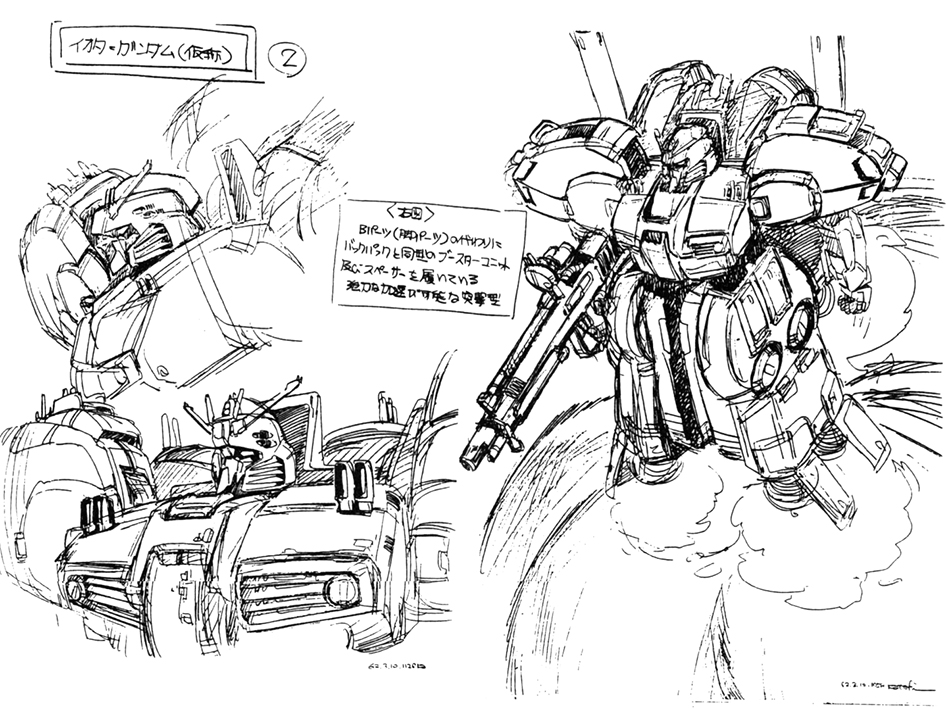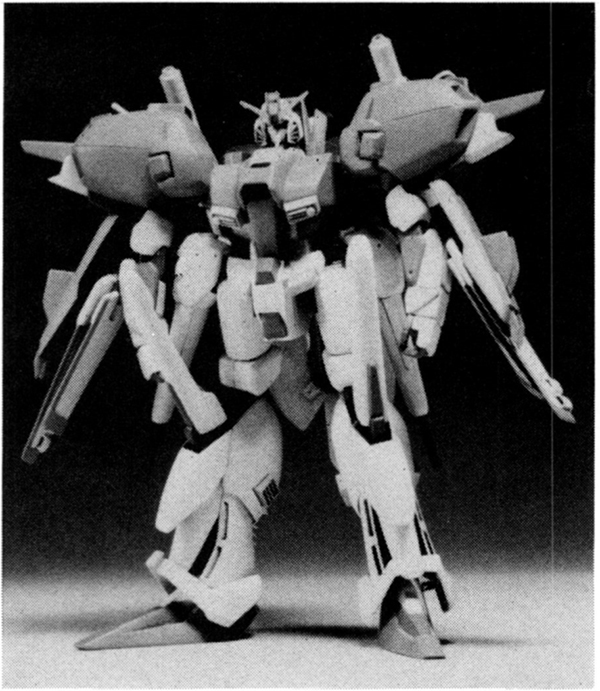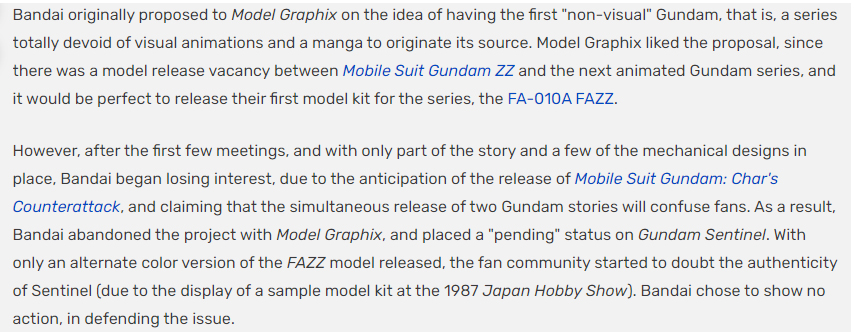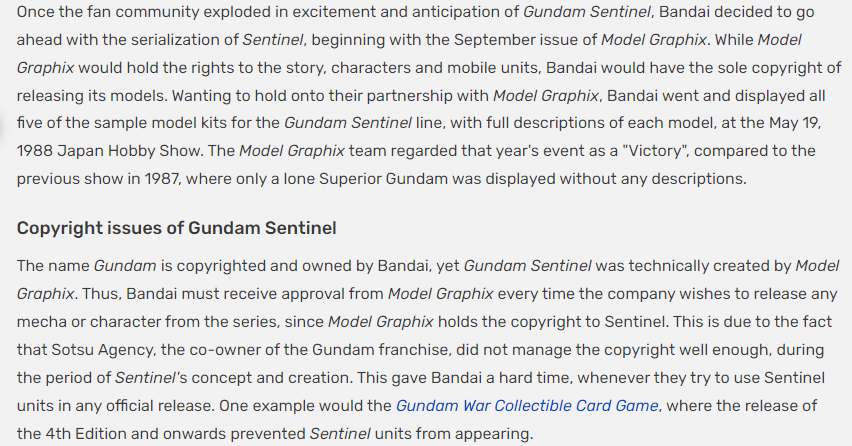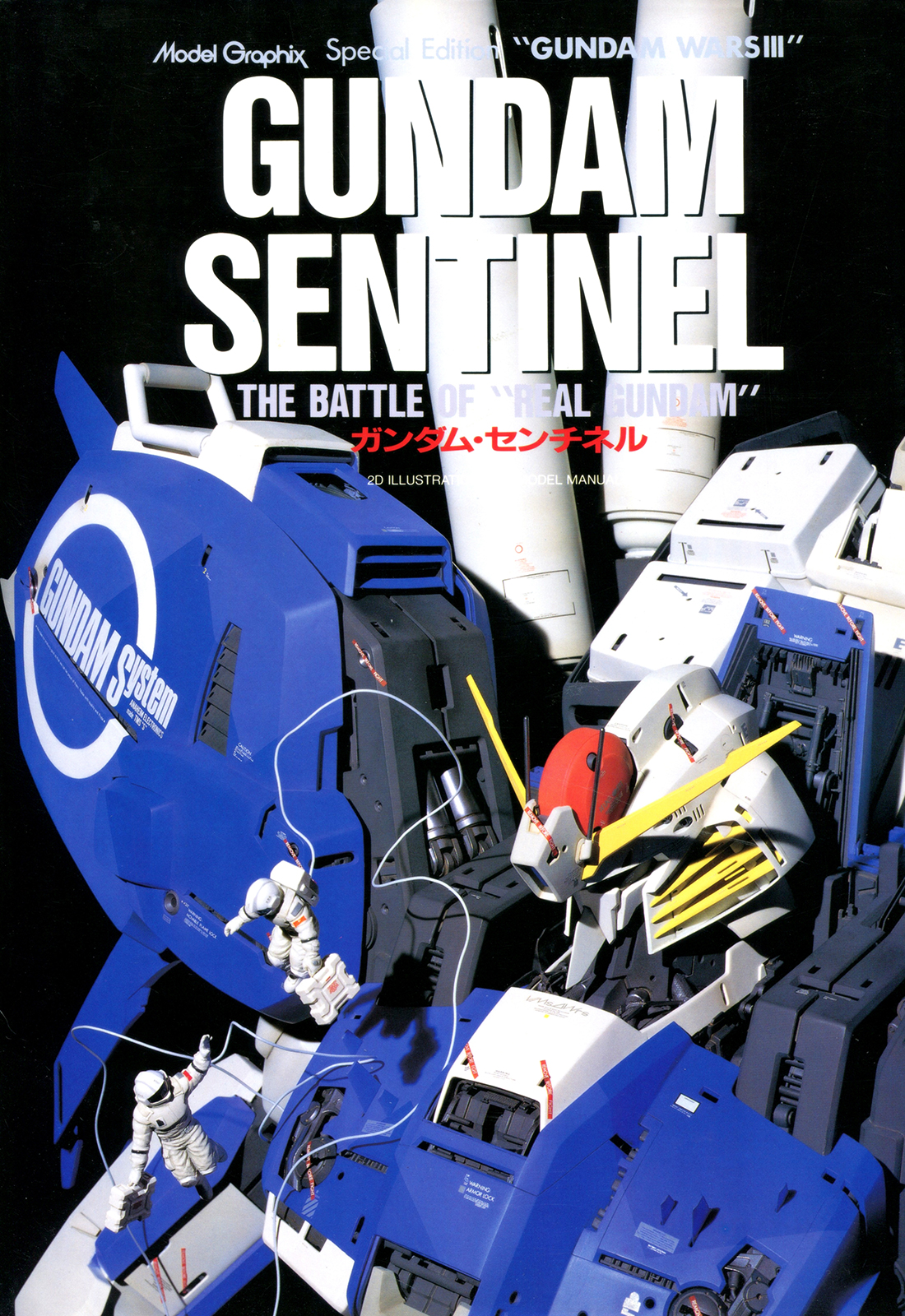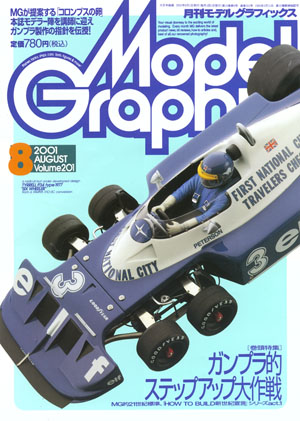ON GUNDAM SENTINEL
OVERVIEW OF SENTINEL
Before I go into the details about the rights situation and those misconceptions, I think it’s necessary to step back and look at the entire process that went into creating Gundam Sentinel. Part of the reason for this is because there’s been a lot of information that’s parroted quite frequently whenever the series comes up in discussion. A lot of it has been quoted and misquoted for so long, and there’s no longer a way to discern fact from fiction. Wikipedia and the Gundam Wiki copy and paste the same chunk of information, so it’s hard to say where that came from (or who machine-translated what from where). Then there was that well-linked to Reddit thread where someone translated a Chinese blog about the whole “copyright situation,” which was entirely fabricated. I don’t do this out of malice or some way to get people to worship me. It’s just me trying to provide the real story to people, which has always been available, but few have gone to look (or double-check, instead).
What would later go on to be known as Gundam Sentinel started as a joint project between Bandai and Model Graphix in February 1987. Bandai’s advertising at the time in various magazines speculated that there’d be a “new Gundam series,” but the reality was that everybody still had a blank slate. During the middle of Gundam ZZ’s television run, staff from Model Graphix had submitted designs for a competition based on the assumption that they’d be turned into model kits. These designs included the EWAC-Zack, Regelgu, Dwadge, and Zaku III. These same staffers were told about design work for the Sentinel project, on the same assumption there’d be 3D kits. All in all, it was a surprise that a “Gundam kit series without video media” started with such a vague situation as a project linked to a magazine medium.
As Masahiko Asano would point out later, Sentinel was originally requested by the sponsor, which seemed to indicate a reinforcement of the traditional commercial image of Gundam. Sentinel was a conservative innovation in the Gundam world system. When he first came on board for the project, everything was pretty much finished, and he intentionally didn’t get involved with certain aspects, which made him feel more like a director. Below, I’ve chosen to summarize his walkthrough of the project.
“THE STRONGEST GUNDAM”
The first project meeting was held in mid-February, and its goal was to confirm the intention of the project and show that the only clear concept presented by Bandai at the time was “the strongest Gundam.” As this new series had no visual medium, the only places where there could be product appeal were in model stores or magazines, which was all that was needed to make it a “product.” Despite the extremely limited media, Gundam had enough impact and marketability.
As the meetings continued, Char’s Counterattack became a problem. While the movie was scheduled to be released in March of the following year, they knew absolutely nothing about it aside from the fact that it took place in U.C.0093 and was about Amuro vs. Char. If they were to design post-0093 mobile suits that ignored the movie, there’d be problems. Plus, there were also issues about following the evolutionary trees after Zeta and ZZ and not creating suits that screwed up potential connections to the movie. This new series, a bridge between the worlds of Z/ZZ and Char’s Counterattack, was enough to make a creator cry. Creating this Gundam was going to be a challenge.
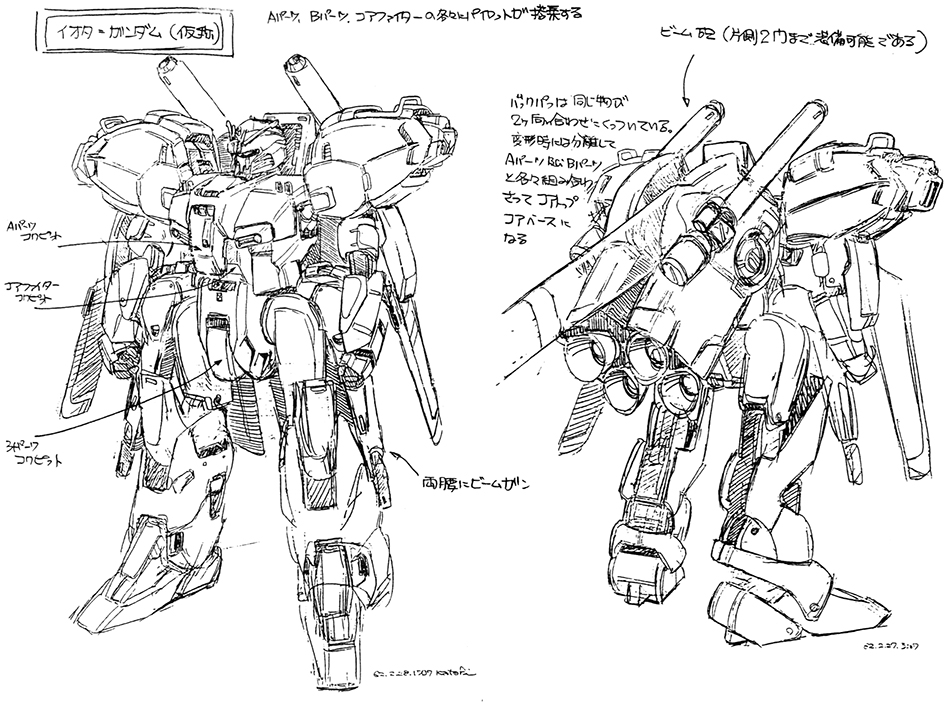
The Iota Gundam was designed by Hajime Katoki. It should be noted that while the plot was completely finished by this first draft, it was still three steps away from being finalized.
IT DOESN’T LOOK LIKE A GUNDAM!
Late February: the concept design of the Iota Gundam was submitted by Katoki. At first, there was a lot of controversy surrounding Katoki’s vision for the “strongest Gundam.” Everyone had their own idea in their heads of what Gundam should be, a difference in values, you could say. While time worked to change the staff’s perception, Bandai still slapped them in the face with a blunt “this is not a Gundam.” They sought to cherish what Gundam was within the flow of the Gundam world. As a manufacturer, they faced a problem that often occurred between creators and publishers: first impressions of a Gundam as a Gundam were important. Other instances include “Gundam’s are much simpler” or “This Gundam feels too thick.”
TRICOLOR MAGIC
As was the case with the Iota Gundam, most of the other designs that had been submitted had been stalled due to “something not being right.” As the Iota Gundam was the “strongest” among the staff, they couldn’t go back to the drawing board, so the concept went through several rounds of tweaks to make it look more like a Gundam before it was presented again. However, for this presentation, there’d be a colored version. Everyone seemed to have a false impression (a stereotype) that a Gundam is tricolored. And, well, coloring the Iota with these colors did make it look like one.
This color draft was submitted to Bandai during a meeting. It was nothing more than three colors applied with markers. The response was, “Ah, yes. Now, this looks like a Gundam.” As stated above, everyone had their own image of a Gundam, and there are more discrepancies than one could imagine. Finding an approximation is more complicated than creating a “new” Gundam. Although the Iota had been drafted many times over, nothing fundamentally changed after the first draft. Simply put: it was painted in the tricolor scheme of blue, red, and white.
WHAT’S SENTINEL
The new series started coming together through trial and error. Nonetheless, considering the timing of the release of the kits for the series, the schedule would leave the team with a period of about half a year “without Gundam.” Their solution was to reconsider the Full Armor ZZ Gundam, which should’ve appeared in the television series, and release that as the first kit in the new series. To differentiate it from the suit in the series, though, the hyper mega cannon was included, and a Model Graphix original pure white color scheme was used. From here, the name was decided:
Gundam Sentinel. Sentinel means watchman or sentry.
The name carried more of a rhetorical meaning than a direct one, implying “a grade above video media.” Now that the FAZZ was on schedule, the Iota Gundam, their second in the series, was in the final stages of its development. Iota Gundam was a temporary name given to the suit by Katoki, coming from the Greek-lettered Gundam series naming convention used by Anaheim Electronics (it would be the seventh in the series that started with the Rick Dias being the Gamma Gundam). Legitimacy aside, the naming was also considered as a means to bridge the gap with Char’s Counterattack. At this point in time (late March), a theory had been established that the new Gundam in the movie would be (at least according to info behind the scenes) the “Hi-S Gundam,” which came from Hi-Streamer, a series in Animage. So, the “Hi” portion was dropped, and “S Gundam” was chosen as a candidate, with Katoki proposing the name “Supreme Gundam.”
At the beginning of April, a cleaned-up version was submitted, and preparations began for the All Japan Hobby Show that was going to be held in Shizuoka in May. They were just one step away from a public announcement.
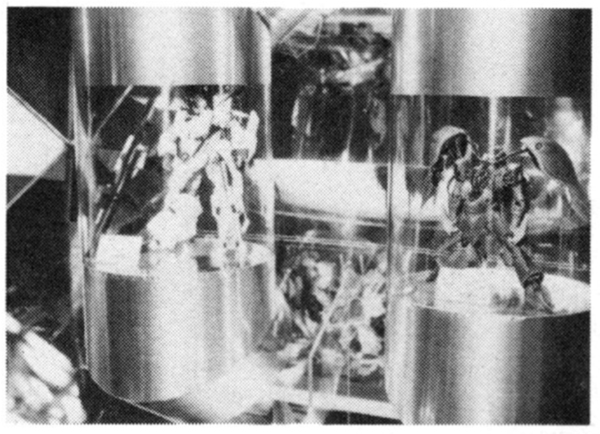
Bandai’s “Gundam” booth at the All-Japan Hobby Show held May 14-17, 1987. The Full Armor ZZ Gundam, No 1 of the Sentinel Series, is on display with the Quin Mantha (a sample display).
SUPERIOR GUNDAM
Based on the tentative draft that had been finished in early April, work on a prototype sample for the All-Japan Hobby show started. There was less than a month to go until the show in May, so Nobuo Suzuki (current editor of Model Graphix) was tasked with being the modeler in charge. He had previously worked on the Zplus with the same staff, so he was the perfect choice for communicating time-sensitive work to be done. But scheduling was so tight, and everything had to be left to him from start to finish. A 1:100 (!) scale prototype sample was on display at the show with a nameplate that only said, “sample only.” There was no Gundam Sentinel series title or even a clear announcement that this Gundam was part of a new series. It was as if Bandai and Asano had yet to come to a consensus, and that part was exposed for everyone to see.
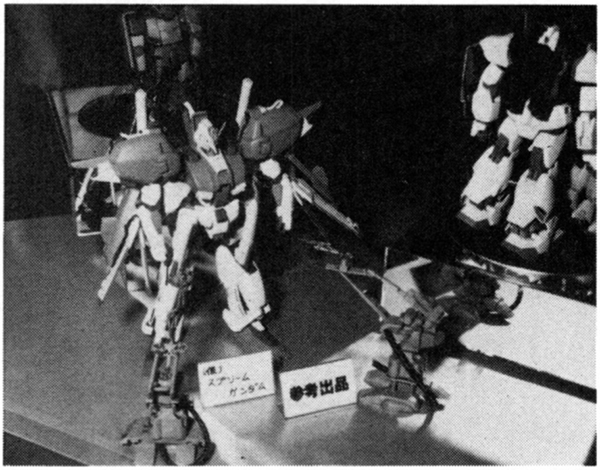
On the left side of the same booth is “Supreme Gundam (tentative name),” but… there was no other specific explanation given.
The public’s view of their half-assed stance was calm, collected, and blunt. Other magazines had sarcastically started asking, “Is this really going to be on sale?” and in an almost chain-like reaction, public opinion shifted to “There’s no way a project like that is going to work” and “That’s not even a real Gundam!”
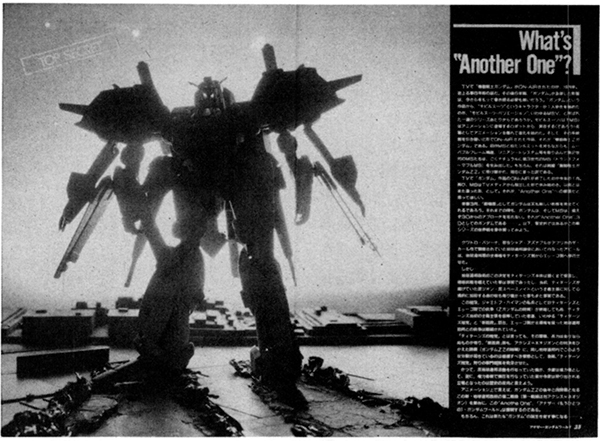
The Supreme Gundam from the June ’87 issue of Model Graphix. The backlit silhouette foreshadows the appearance of a new hero!
So, the 1:100 version of the Supreme Gundam pictured above was published as a so-called “scoop” for both publicity and market research. Still, even in the magazine, reactions to this new “Gundam” were tepid at best. “You can’t possibly call this gaudy thing a Gundam” or “It’s not a Gundam if there are slits in the ears” were some of the reactions from readers (especially fans of older works) who were flat out denying everything as what they were seeing went far beyond their values of what Gundam was (as mentioned earlier). Plus, it didn’t help matters that the project was being carried out in an entirely closed system where information was more or less suppressed, so many modelers (even those working for the magazine) learned about the project and the Supreme Gundam for the first time from that very issue. Almost all of them took the same “negative” stance as their readers.
While this was expected, to some extent, it was understandable from a promoter’s point of view, but from a director’s angle, it was cause for concern. This was true for both sides. Although the Supreme Gundam was later renamed “Superior Gundam” for product registration purposes, in the end, it didn’t pass the registration process either. Right after that, Bandai had informed them that the project would now be “pending.”
CHAR’S COUNTERATTACK
Although upset about the answer given by Bandai, the team knew that, in theory, it was pointless. As this was a joint project, if any one of them had an issue, it would be a joint one, and nothing could be done about it. The “reason” that Bandai had given was that the design process for Char’s Counterattack had progressed faster than anticipated, so to continue with the video media, designing kits as soon as possible was a better venture and that it would cause confusion if there were different Gundams saturating the market at the same time, even if they were all under the same banner of Gundam. Although the project was deemed “pending (postponed),” it was effectively “canceled.”
BATTLE OF SENTINEL
Facing what seemed like utter defeat, the team reached out to Newtype magazine editor Inoue to run a special in the magazine as a way to transcend genres and drum up popularity for the project. It worked, and in the August 1987 issue, there was a special included in the magazine’s “GUNDAM SAGA II” billed as “This is the real deal!!” The reception was much better than their previous gaff, so Model Graphix started developing their own “Gundam Sentinel” magazine in the September issue, which was a complete overhaul as a Model Graphix-only project with a variety of intentions. It was a completely fresh start, and they had nothing that could be trusted or relied on in any definitive way.
MOVEMENT
Sentinel came to be very well received from the first issue. Fans thought the mobile suits were not only cool, but they loved how realistic everything was. Everything was coming together for them: the mobile suits were popular, they had a story by Masaya Takahashi, and some high-tension 3D models to boot. By March 1988, injection kit production for the series was suddenly realized. On the surface, it was just “resuming” things, but in reality, it was more of a “realized.” With the release of the Char’s Counterattack movie out of the way, kit production was moving full speed ahead.
AN INVITATION FROM ALICE
Four more items were added to the kit list, and the Sentinel series lined the shelves at model stores. The kits took off better than expected, and while it would’ve been easy to write it off as a victory from media mix, it really only just proved that Gundam as a character had evolved as a chapter independent of external media. What was initially supposed to be a project for heavy users, it drew in elementary and junior high school students. What was essentially a guinea pig project was probably one of the biggest gains for the modeling industry.
The downside to all this, though, was that everything being linked to a single magazine could pose problems for other magazines choosing not to publish things. Plus, there was the debate (or dispute even) between Model Graphix and Bandai over whether they were “resuming kit production” or “realizing kit production.” In conclusion, everything for the project seemed a bit too rushed. As everything gained traction, and the more the overall framework became more apparent, the more (Asano) realized, albeit belatedly, that a lot of the stuff that should’ve formed their base of the movement relied entirely too much on the indulgence of their hasty start.
Now, onto some of the claims that’ve been making their rounds online for quite a long time. These are all screenshots taken from the Gundam Wiki, which have since been mysteriously removed prior to my announcing this article. I’ve taken screenshots as receipts.
CLAIM #1:
(Source: Gundam Wiki)
The first claim here is more or less made up of half-truths and false assumptions. As indicated above, while Bandai did approach Model Graphix, there wasn’t a formal plan of what they wanted to do, only a vague idea. Next, the only reason for a vacancy was due to the amount of time necessary to ramp up production for the kits. The release of the FAZZ was only a stopgap measure of sorts to give them more time.
The story for Gundam Sentinel was finished. It was only the mechanical designs that were running into issues. It wasn’t so much that Bandai was losing interest, so I’m not sure where that assumption came from. A multitude of factors played into things, but they didn’t “abandon” the project, nor was there really a “doubt” over Sentinel. As it was stated, it was shock over how vastly different the design was compared to Gundam designs up to that point.
CLAIM #2:
(Source: Gundam Wiki)
I have absolutely no idea where this information came from. If I had to guess, I’d say someone just looked at the pages and went, “Yup! This is all about Sentinel!” and was done. While I’m waiting for my physical copy to re-verify what I have currently dug up, photos of the August 1987 issue of Newtype magazine indicate that the “Gundam Saga 2” special is a 12-page promotion of the upcoming Char’s Counterattack movie as well as some minor PR for Gundam Sentinel among other things. To borrow the words of Skippy the Magnificent, let me break it down for you Barney style:
- The first four pages of the article contain promotion images for the upcoming Char’s Counterattack movie, complete with alternative designs for the titular mecha and alternative colors for characters.
- The next two pages are a “complete timeline” for the Universal Century.
- Next, there is a color “mechanical view” spread of the Superior Gundam by Hajime Katoki and Osamu Tsuruyama. It contains detailed explanations for various sections of the suit. The text on the side of the spread reads, “This is the real deal!!” An inset discusses Bandai’s plamodel series (specifically the rise of the Mobile Suit Variation lineup).
- The next set of pages depict artwork by Hideaki Anno of a Nero fighting two Xeku Eins, none of which are the type indicated by the Gundam Wiki. As this is a teaser for the project, their names were different. They are listed as “Xeku Eins” and “Xeku Eins Rapid-fire Gunner Type,” respectively.
- The final spread shows us the Superior Gundam’s G-Cruiser mode and booster-equipped type. The artwork appears to be by Katoki and Tsuruyama again, but I’m unable to tell at the moment from the photos I currently have. There is also an article on the spread by Tomino about how the world of Gundam is thriving outside of his hands now.
First, let’s go back to the claims that there is a “brief, detailed” introduction to Gundam Sentinel. I’d hesitate to call it that. The text reads:
“U.C. 0087. The appeal made by Quattro Bajeena, or Char Aznable, at the Earth Federation Assembly in Dakar, Africa, shifted the leadership of the Earth Federation Forces from the Titans to the AEUG. There were, however, there was no shortage of people who were sympathetic to the Titans’ initial anti-Zeon and anti-Spacenoid principles. Thus, even after the war between the AEUG and the Titans (Jamitov’s private army) ended, the struggle between the ‘remnants of the Titans’ and the Earth Federation government, which the AEUG side had taken leadership over, continued.
At the time of the confrontation with Axis (Neo Zeon), it was alarming that such a division was occurring within the same Earth Federation, and the AEUG hastily formed a specialized unit to hunt down the Titans remnants. Another Gundam World, Gundam Sentinel, depicts the struggle between the AEUG, using the Pegasus III as their flagship, and the remnants of the Titans who are calling themselves the New Decides.”
Okay, I suppose that tells us something, but it leaves us with more questions than answers about what, if anything. So what follows is basically the promotional blurbs for the project.
“Truth be told, this Gundam Sentinel series (tentative title) is an original project that is unrelated to the theatrical version of Gundam and is being developed on the assumption that it will be ‘made into models.'”
The text discusses how “Gundam” has become a genre of its own in model magazines. It says that, for example, Model Graphix magazine has articles on AFVs, aircraft, motorbikes, SFVs, animation, articles on Gundam, and whether it’s on tv or not. The Gundam Sentinel series approach would be “Gundam as a model (aka 3D).” It’s noted that for this project, mobile suits are designed to satisfy the 3D user side without being bound by television media. In other words, it’s all about the details and gimmicks.
At the time of publication, it’s noted that the project is still in the planning stages as of mid-June and that if there are any Newtype kids out there who’d like to be a part of their “Another Gundam” project, they should send a postcard addressed to Bandai. Depending on the reaction (to these pages), there’s a possibility that things would move forward.
Now, onto the clarification. It’s frustrating, to say the least, that the assertion is made that the editor of Newtype magazine was somehow frustrated by events of another magazine that he’d intentionally run a special in his. According to text from the “What’s SENTINEL?” section of the Gundam Wars III book, Masahiko Asano, the editorial director (among other positions on the project), explains the following in the Battle of Sentinel subsection:
“The only thing I’d like to talk about is the ‘planning system’ in Japan. In the United States, there are planning fees paid each time, and whether it is approved or not, the copyright goes to the planner (creator) until the end. In Japan, however, it’s the exact opposite, and things start circulating as soon as they’re established. For us, it may sound like a ploy, but we couldn’t just put Sentinel on hold at this point. That’s how much time, effort, and authorship went into this project.
The only thing that mattered to us was getting the product back out on the market no matter what the cost. So our “battle” to make this happen was on.
The first thing we had to do was make Sentinel publicly recognized. We had to make a broad appeal to the public, letting them know that it wasn’t a paradox but ‘real Gundam.’ We wanted to show it to as many people as possible, and if possible, in a medium other than model magazines.
Fortunately for us, when I approached Inoue of Kadokawa Shoten’s ‘Monthly Newtype’ editorial department, he agreed. In the August 1987 issue (on sale July 10), there was an article titled ‘GUNDAM SAGA II’ with some copy text of ‘This is the real deal!!’ and cel work of the Superior Gundam by Katoki. What’s more, there was also cel work of early draft versions of the Nero vs. Xeku Eins by animator Hideaki Anno across the next spread. Plus, I was able to devote some space to a PR piece (yes, a full PR piece, not just some copy text!) to Sentinel by myself. “
Asano goes on to explain that they received a reasonable reaction out of it. As a result of their linking up with a magazine that transcended genres drew attention to their project, and although it was a rather calculated move, it gave them a foothold. So, Model Graphix started developing their own “Gundam Sentinel” magazine in the September issue, which was a complete overhaul as a Model Graphix-only project with a variety of intentions.
CLAIM #3:
(Source: Gundam Wiki)
There is where things get muddled and complicated to sort through. Bandai didn’t decide to go ahead with the serialization. Gundam Sentinel’s serialization began in the September ’87 issue of Model Graphix magazine, but the plot and designs were reconfigured, and it became “Model Graphix’s Sentinel.” And yes, at Bandai’s booth at the All-Japan Hobby Show in 1988, the Sentinel series was “proudly displayed.” Considering the year prior, it was a “huge, unexpected twist.” Their victory didn’t so much come from the hobby show itself, but the overall reception to the story and the kits being sold.
Now, onto the matter of rights/copyright/usage or whatever you want to call it. The August 2001 issue of Model Graphix has an article published in it that Katsumi Kawaguchi writes as a means to dispel the rumors and myths that’ve been circulating since an explosive report in Hobby Japan earlier in the same year. I’ve translated that page for you all here:
REPORT ON THE CURRENT SITUATION AND ANNOUNCEMENTS REGARDING FURTHER INFORMATION DISCLOSURE ON THE MOVE TOWARDS “REPRODUCING SENTINEL KITS”
Since December of last year, Bandai and Artbox have been discussing reproducing Sentinel kits. It has been a very complicated and daunting task involving attempting to correct each and every mutual misunderstanding and broken promise accumulated over the past decade to create future guidelines for “Sentinel” content.
Unfortunately, a report in the July 2001 issue of Hobby Japan magazine led to an explosive spread of rumors having little basis in the facts of this matter. These have now reached a level at which they could hinder the progress of further discussions.
Here, Mr. Kawaguchi of Bandai has stated, “I would like to extinguish these rumors by reporting the actual situation in Model Graphix magazine.” Model Graphix editorial department has also acknowledged this, and as such, a special page was set up here.
Text by Katsumi Kawaguchi (Bandai Hobby Division)
© Sotsu Agency & Sunrise
SENTINEL CONTENTS
The contents of Sentinel have occupied a unique position due to the process of its creation. Since the details are described in this magazine’s separate Sentinel volume, they will not be expanded upon here. Essentially, following the TV broadcast of “ZZ,” a new Gundam was planned for release. At that time, Bandai’s Hobby Division approached Artbox for a tie-in project for the first time in the magazine’s history. Artbox began planning and securing personnel in anticipation after receiving this request. However, with the release of the movie “Char’s Counterattack,” the priority for commercialization shifted from “Sentinel” to “Char’s Counterattack,” and the tie-in was canceled. After discussions with Bandai, the project team, which had been preparing, decided to restructure the plan and start serialization as an independent magazine project. This is how “Sentinel” got its start.
After this, and once the product on the market from “Char’s Counterattack” settled down, Bandai proposed putting Sentinel mobile suits on the market to Artbox while considering the launch of the next series. Once again, moves to start commercialization in the form of a tie-in started. Although the terms and conditions, etc., for tie-ins, are considered, as much as possible, with mutual benefit in mind, it goes without saying that the benefit lies in merchandising for new Gundams for Bandai. By contrast, the benefit for Artbox lay in:
- The payment of planning cooperation fees
- As a general rule, the fact that Artbox would take the initiative for putting the product on the market
- The payment of a usage fee (royalty) for each mobile suit product appearing in Sentinel
And so on. Promises were made orally for each of these at the time. In addition, after the decision to commercialize four items from the series, modified kits and garage kit projects for the other mobile suits were presented to and approved by Artbox. Unfortunately, the promises made regarding this matter were not left in writing. Due to internal circumstances at Bandai, notably personnel changes, the circumstances of the establishment of this aspect of Sentinel were not conveyed to other members of the organization.
Someone in charge of product development with no knowledge of this background only knows that “Sentinel is one of Gundam’s variations” and commercializes it based on such knowledge. As a result, previously-made promises were violated. Despite actions from Artbox asking for the promises made to be fulfilled, people in charge who did not know the circumstances replied to the effect, “Since Sotsu Agency and Sunrise own Gundam, what is the problem with it being commercialized through mutual agreement between the two parties?”
Such cases were repeated a few times, and “Sentinel” gradually developed an image as content that was difficult to handle. This prejudice of “difficult to handle content” was gradually transformed into a misunderstanding that “Sentinel” couldn’t be commercialized because Artbox was claiming copyright. The relationship between the model magazine and the manufacturer, which is maintained by mutual trust, cannot function smoothly in such a situation, and the distance between Model Graphics and Bandai gradually increased.
This situation led to the start of whispers and rumors to the effect that “Bandai has approached Artbox to commercialize Sentinel, but there seem to be difficulties related to a variety of issues,” and “Sentinel hasn’t been officialized because Artbox is claiming rights.”
TOWARDS RENEWING COMMERCIALIZATION
Since I myself was not a part of the Hobby Division at the time, I was not in a position to know the details. However, since it was necessary to confirm why the Sentinel mobile suits became difficult-to-handle content when considering its renewed commercialization, I did conduct hearings from as neutral a standpoint as possible.
Following these, I judged that in order to move forward with the project, it was first necessary to talk to Artbox about renewing commercialization. We have been talking about this since the end of last year. My understanding is that Artbox has no desire to “claim rights” (copyright) but instead wants the creation of “a forum for discussions,” which have not been held since the original promises were made. The kinds of topics that should be discussed in this forum include the special position of the “Sentinel” content, as well as the creation of a mutual understanding with regard to how this content will be handled going forward. Of course, this is not something that can be done overnight; it is something that must be built up over time in the future. However, I am convinced that the first step towards that end goal has already been taken.
Since I was involved in these discussions, the “Announcement to Start Sentinel with GFF” featured in the July 2001 issue of “Hobby Japan” was a shock to me. Typically, one would think that each business division within this company called “Bandai” would obviously cooperate and exchange information. However, the current Bandai was formed as a group company by integrating originally separate companies. Whether latent or actual, a feeling of competition between the different business divisions persists.
Inevitably, those who have lost their sense of competitiveness are weeded out. In this sense, I do not think that a feeling of intra-company competition is terrible. However, in my opinion, the Hobby Division’s number one rival for the last few years has not been Tamiya or Hasegawa, but rather the Character Division. To put it bluntly, I have decided to write this because, while the Hobby Division has been carefully laying plans for GFF’s Sentinel mobile suits since the beginning of the year and proceeding with the renewal of commercialization work for the Sentinel mobile suits in consultation with Artbox, the party to whom previous “promises” were made, there has been speculation that we were simply falling further and further behind.
Because of the rumors about “Sentinel” mentioned above, the topic of the “commercialization of Sentinel” has received considerable interest, for both positive and negative reasons. I could actually feel this from users’ reactions after June 25th. This is why we recognize that we have to carefully consider how to treat the peculiar nature that is “Sentinel.” However, on the other hand, I do hope that understanding the pride of having had the “Gunpla” products support the “Gundam” contents for over 20 years, readers can understand that the Hobby Division is now working towards the renewal and commercialization of Sentinel mobile suits, including in the HGUC and MG series.
NOTES:
Artbox: the editing production which edits this magazine
GFF: Gundam Fix Figuration are toys by Bandai’s Character Division
Below are the sources used for information presented on this page.

PUBLICATION INFORMATION
Publisher: Dainippon Kaiga Co., Ltd
Published: 1989.09
Price: 2800 yen
Size: —

PUBLICATION INFORMATION
Publisher: Dainippon Kaiga
Published: 2001.06.25
Price: 817 yen
Size: A4



